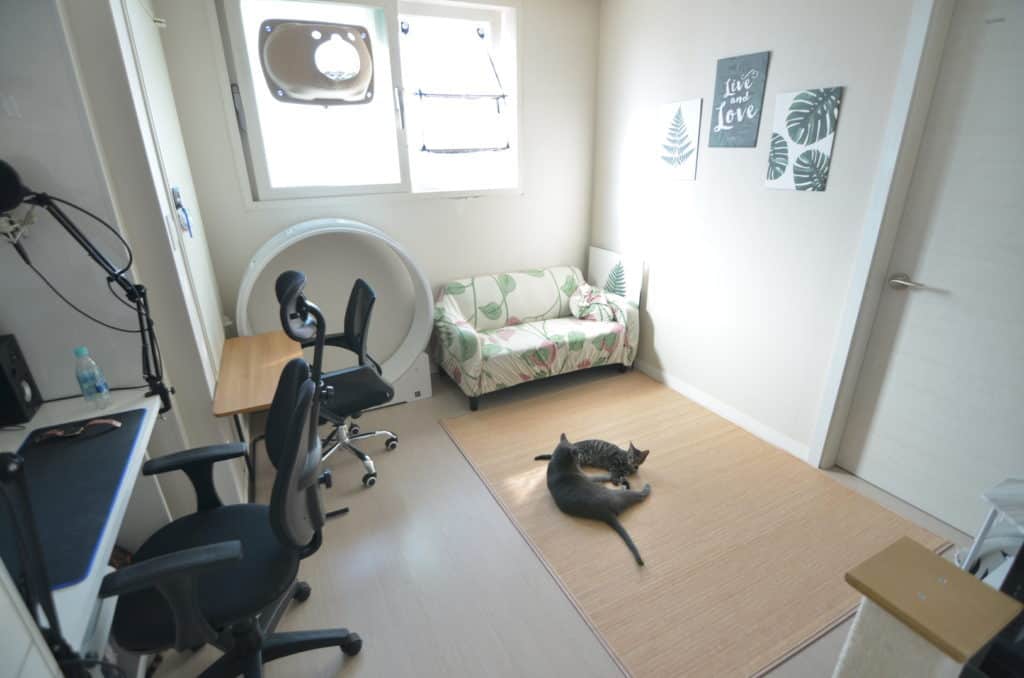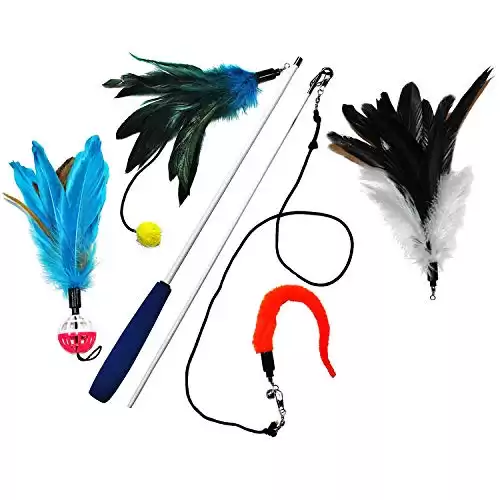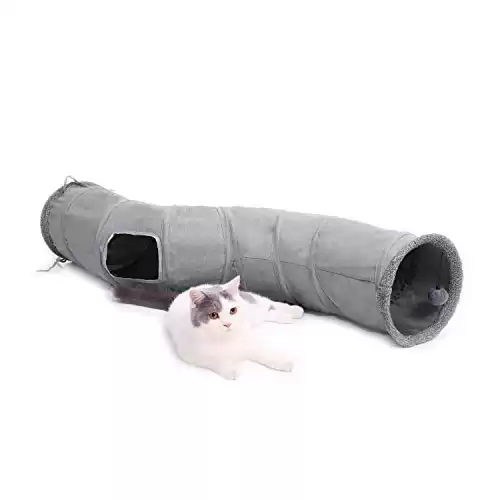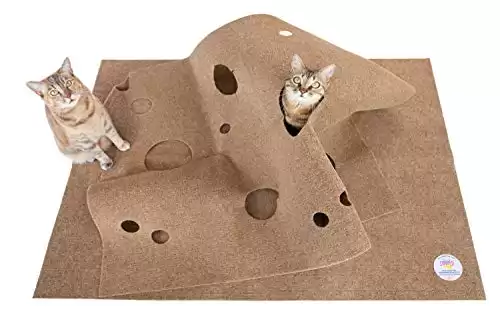As urbanization increases around the world and more people are living in city centers, flats, and apartments. Thus, it’s logical for indoor-only cats to rise in numbers as people want companionship in these types of living arrangements.
While we know cats as quite independent pets, the misconception is that cats are more hands-off or low maintenance or can be detrimental to their mental and physical health. While they do not require as much direct attention as dogs, being cat owners, there are other things that we have to focus on to ensure their proper development.

So do indoor cats get stressed or depressed? Cats can definitely get stressed or depressed if their indoor environment is not enriched in a way that serves a cat. Also, a big part of a cat’s quality of life is in its play regimen. According to some studies, cat owners are lacking the knowledge and methods for proper interactions with their cats which could be lead to behavioral problems down the road.
Although it’s true that indoor cats have a lot less stimulus than cats with outdoor access – the risks associated with outdoor access are simply not worth the risk and might not be possible for owners living in apartments.
Signs Your Cats Might Be Stressed Indoors
Cats are masters of hiding their stress so it might not be obvious if you’re not looking for it. Here are the telltale signs of stress and depression in cats:
- Improper elimination outside the litter box
- Over-grooming, scratching, or overly aggressive
- Trying to isolate themselves for increased periods of time
- Lethargy, unwillingness to play, or sleeping for more than usual
- Not eating as much as they’re used to or not eating altogether
Being aware of any deviation from your cat’s daily schedule and routine is important in diagnosing issues that your cat might have. Therefore, if your cat starts to exhibit any of these signs – it’s a good time to start taking notes to get down to the root of the problem.

One benefit of having an indoor-only cat is that it’s very easy to know where your cat has been, what they’ve been eating, and what behaviors they’ve been exhibiting because of the increased frequency in which we interact with our cats compared to outdoor cats. As a result, this makes it easy to spot problems quickly and bring our feline friends to the vet if need be.
Why a Cat Might Be Stressed or Depressed Indoors
As cat owners, there is always something that we can improve in the care of our cats, whether it’s how the environment is set up or the time that we spend with our cats. The willingness to keep learning about our pets is important to keeping them sharp mentally and physically. However, there are times when we might neglect certain parts of our cat’s development.
According to a 2014 study: owner survey of toys, activities, and behavior problems in indoor cats, a survey was set up for cat owners to record the frequency and duration of the daily interactions with their indoor cats, the toys and activities they do, and the occurrences of 6 behavior problems. These 6 selected behavior problems were:
- aggression to owner
- aggression to visitors
- periuria (the scientific term for urinating outside the litter-box, or in unusual places)
- inappropriate defecation
- inter-household cat aggression
- interact aggression to outdoor cats
There was a total of 277 clients surveyed from 5 veterinary practices who presented their domestic cat for anything except a behavior problem.
Here were the highlights & implications of the survey:
- The average number of toys/activities reported per cat was 7 (and almost all of them were miniature independent play toys such as furry mice, catnip toys, and balls). A total of 78% of the owners reported that they leave cat’s toy(s) available all the time on the floor.
Among the toys and products that they had, cat trees, tunnels, and cat interactive toys were closer to the bottom of the list (meaning only a few owners had these types of items – only 9 out of the 277 clients had cat trees or tower!).
**This implies that a majority of cat owners either lack the knowledge of how a cat likes to play or they simply did not care to ask. Cats are hunters and so their playtime and environment should simulate and support this instinct. Therefore, the combination of interactive play along with environmental modifications is the most optimal in supporting this aspect of your cat. - There was a significant relationship between owner-cat playtime and the number of behavior problems that occurred. Significantly fewer behavior problems were reported by owners that played with their cat for more than 5 minutes.
Most owners (64% of the owners) played with their cats twice a day for 5-10 minutes. However, the study wasn’t specific about what type of play that the owners engaged in with their cat. As some owners reported tricks, and some owners reported different things entirely. However, it does suggest that owner-to-cat activities are important in minimizing behavior problems and stressors.
**For free-ranging cats, the average duration of hunting sessions is about 30 minutes, suggesting that many owners are not meeting the individual cat’s behavior needs. - Owners that reported that they did not provide a companion for their cat were 4.2 times more likely to report interact aggression with other cats.
**This makes sense as cats that are able to have a companion early in life learn social and behavioral cues from each other (read the science that backs it here on my article!). A cat that hasn’t had any experience with other cats is likely going to be more territorial than cats that have had companions all their lives.
Conclusion: Preventing Stress and Depression in Cats Indoors
Knowing what a cat wants or any animal for that matter can sometimes be difficult. Surveys and studies such as the one above can make the picture a little bit clearer for cat owners to use for their own cat’s enrichment.
Here are the main points to prevent stress and depression in cats indoors:
- Specific activities that support our cat’s need to hunt and explore (i.e. interactive toys, environmental products, and catification)
- A play regimen of at least 20-30 minutes a day. For the most optimal play routines, click here!
- Providing our cats with a companion. This is obvious but often overlooked. If you plan on having a cat – it’s always a good idea to introduce a friend.
Recommended Interactive & Environmental Toys/Products
 Pet Fit - 4 Piece Rod + Variety Prey Set
Pet Fit - 4 Piece Rod + Variety Prey Set
This prey-set brings great variety to fit all cat's hunting preferences. This allows you to try a lot of different types of prey for your interactive wand and has great reviews.
-
 Check Price!
Check Price!When your cats need to expend some extra energy and you don't exactly have the time to play with them directly - create a play situation so that they can play with each other. This is great for multi-cat homes and folds up neatly when it's not being used. Lots of different designs to fit your home aesthetics too!
We earn a commission if you click this link and make a purchase at no additional cost to you.
-
 Check Price!
Check Price!While it takes up some horizontal space on the floor - this is such a great tool to let your cats hide and burrow and be cats. Multi-cat households love this item because of its durability and effectiveness. Also folds up neatly to be put away and organized!
We earn a commission if you click this link and make a purchase at no additional cost to you.
